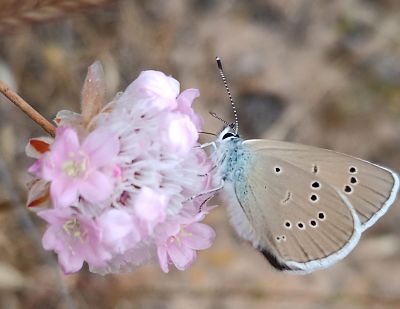Cyaniris semiargus is a small lepidopteran from the Lycaenidae family that reaches in Doñana its southernmost distribution limit. At this latitude, besides Doñana, it its only observed at higher altitudes in the Sierra Nevada mountains. The Doñana population can be considered a rarity, associated to wet microhabitats linked to subsuperficial groundwater levels. These conditions allow for population persistence despite the high temperatures and scarce rainfall.
In spring, adults emerge in the dry shrubland (monte blanco) where the food plants, Armeria velutina, grows (see picture by Isidro Román). In May 2021, members of Doñana's Biodiversity Monitoring Group (ICTS-RBD) observed adults flying during the butterfly surveys performed between March and October. These surveys form part of Doñana's long-term Monitoring Program and are integrated in the National Butterfly Network (BMS-Spain) and the European Butterfly Monitoring (eBMs).
Cyaniris semiargus presents sexual dimorphism (different coloration in males and females), which allows for sex identification as they fly. The upper (dorsal) side of the wings is purple in males and brownish in females. Both can be differentiated from other lycaenid species by the lack of moon-like orange marks in the lower rim (submarginal part) of the posterior wings.









 Open Call for Research Projects in ICTS-Doñana!
Open Call for Research Projects in ICTS-Doñana!


